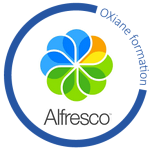This course allows you to pause and replay sections.
You will find step-by-step instructions with video demonstrations and audio narrative, your learning is tested through a series of quizzes.
The course is enhanced through online labs in a real environment.
Programme
Introduction
Architecture and Technology
-
Looking at the basic building blocks of an Alfresco system, how the components fit together and the information required to build a system architecture for a production system.
- Architecture review
- Start-up and connecting
- Key architecture decisions
- Minimum configuration requirements
- Subsystems
User Interfaces
- Familiarizing you with the Alfresco user interfaces so that you can understand strength and weaknesses of each and are able to create, edit and manipulate content in the repository.
- Standard interfaces
- Share
- The Share architecture
Users and Groups
- In this section we will look at the creation and management of users and groups within Alfresco. We also look at the relationship between users and roles and the options for authentication within Alfresco.
- Users
- Groups
- Authentication
- Roles
Security and Permissions
- Alfresco provides a very sophisticated and flexible security model, in this section we look at this model from a high level perspective. In order to provide a smooth user experience the security model is simplified through the use of roles and permission groups, we look at how these work and how you can easily manage security based on these methods.
- Overview and Concepts
- Authentication
- Roles/Permission Groups
- Managing permissions
- Permissions
- Low level permissions
Repository Configuration
- Starting with basic principles and building on the knowledge gained in the Architecture Section we look at repository configuration and the tools available to an Alfresco System Administrator. Moving on we look at security covering users and groups, permissions and the use of external authentication such as LDAP.
- Understand how repo configuration is done
- What types of things can be configured
- Configuration boot-strapping
- Configuring Subsystems
- Advanced configuration
- Deploying extensions
- Best practices
Managing the Repository
- Repository management consists of the tasks required to ensure that you have a reliable and well performing repository, as well as managing on-going tasks which may change the repository or require adjustment. The regular on-going tasks include monitoring health and usage of the repository and preventative maintenance. At other times you may need to install applications and change the times and frequency of scheduled jobs. Alfresco provides a very powerful way to add rules to folder to provide creative solutions for automating and managing your content, we will look at what you might use such rules for and how you can set these rules up as an administrator or developer.
- Installing applications
- Scheduled jobs
- Monitoring health
- Monitoring usage
- Preventative maintenance
- Managing content using rules
Content Model Overview
- In order to use Alfresco content models developers need to be able to understand the terminology behind content models, understand what a content model is and the different way models may be implemented and bootstrapped. Finally we look at the way models are manifested to the user in the user interfaces
- Nodes, node ids
- Relationships, types, aspects, associations
- What is a content model
- Built in types and aspects
- Deploying a content model
Creating Content Models
- In this section we learn how to create new content models and understand what can and can’t be done in a content model. We look at all the components of a content model and how to deploy and test new content models, best practices are covered as part of the development approach.
- Content models explained
- Types and properties
- Deploying content models
- Associations, aspects and constraints
- User Interface Manifestation
- Advanced Topics
- Best practices
Developing Applications in Alfresco
- In this section we look at the different approaches to application development with Alfresco, the different APIs available and help you to decide on a good approach to application development.
- Application development choices
- Approaches to application development
- Source code

